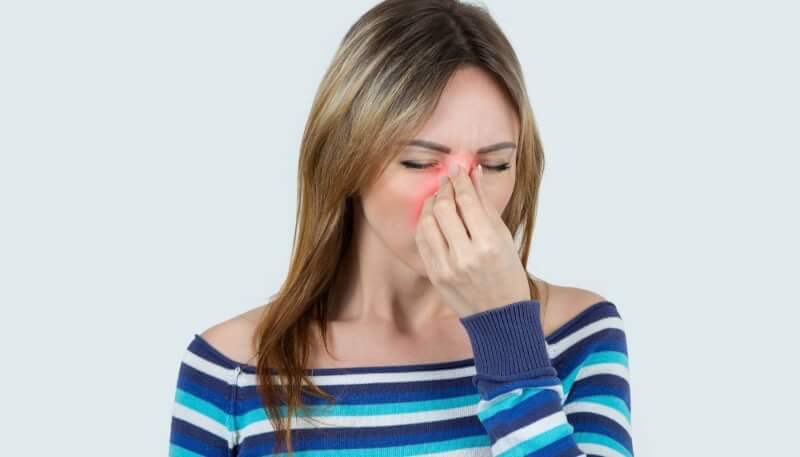What is Sinusitis?
The sinuses are located in the forehead, cheeks, and nasal cavities. When these areas, which are normally filled with air, become inflamed due to various reasons, it is called sinusitis. Allergies, viral or bacterial infections can block the sinuses, causing them to fill with fluid over time. This may lead to pressure on the face, nasal congestion, and fever.
Sinusitis in Children
Sinusitis in children usually occurs due to colds or allergies. All four types of sinusitis can be seen in children, which occur due to the inflammation of the sinuses.
Symptoms of Sinusitis in Children
The symptoms of sinusitis in children vary according to their age. The most common symptoms by age group are as follows:
Symptoms of sinusitis in younger children include:
- Runny nose lasting 7 to 10 days
- The discharge is usually thick green or yellow in color, but it can also be clear.
- Night cough
- Children under 5 years old do not usually experience headaches.
- Occasional daytime cough
- Swelling around the eyes
Symptoms in older children include:
- Swelling around the eyes, which worsens in the mornings
- Runny nose and cold symptoms lasting more than 7-10 days
- Sore throat
- Post-nasal drip
- Fever
- Headache
- Cough
- Facial discomfort
- Bad breath
Causes of Sinusitis in Children
Sinusitis in children usually occurs after upper respiratory tract infections or colds. Other possible causes of sinusitis in children include:
- Allergies
- Nasal structural abnormalities
- GERD
- Dental infections
- Cleft palate
- Nasal trauma
- Foreign objects stuck in the nose
Additionally, when the flow of secretions from the sinuses is obstructed, bacteria can multiply, leading to inflammation and thus, sinusitis. The most common bacteria that cause acute sinusitis include:
- Streptococcus pneumoniae
- Haemophilus influenzae
- Moraxella catarrhalis
In children with chronic sinusitis, pseudomonas should be targeted instead of the bacteria mentioned above.
Diagnosis Criteria for Sinusitis
To diagnose sinusitis, the patient's symptoms must first be evaluated, followed by an ear, nose, and throat examination. During this examination, the presence of swelling, discharge, or blockage is checked. Additional tests may be required to confirm the diagnosis.
Tests used to diagnose sinusitis include:
- Nasal endoscopy
- Nasal swabs
- CT scan
- Allergy testing
- Biopsy
Symptoms of Sinusitis
The most common symptoms of sinusitis include:
- Post-nasal drip
- Nasal congestion
- Thick yellow or green nasal discharge
- Pressure, especially around the nose, eyes, and forehead
- Increased pressure in the face with head movement
- Fever
- Pressure and pain in the teeth
- Ear pressure and pain
- Fatigue
- Cough
- Headache
Advanced Sinusitis Symptoms
Advanced sinusitis, also known as chronic sinusitis, has the following most common symptoms:
- Runny nose
- Clear, thick nasal discharge
- Post-nasal drip
- Nasal congestion
- Pain, swelling, and tenderness around the eyes, cheeks, or forehead
- Reduced sense of smell and taste
- Bad breath
- Ear pain
- Cough
- Headache
- Toothache
- Sore throat
- Fatigue
Brain Sinusitis Symptoms
A sinus infection that spreads to the brain can cause serious symptoms, which vary depending on the type and location of the infection. Symptoms of brain sinusitis include:
- Coma
- Sudden high fever
- Seizures
- Stiff neck
- Vision changes
- Personality changes
- Altered consciousness
- Headache
Sinus Migraine Symptoms
In sinus migraines, a type of migraine, patients experience the following symptoms:
- Headache, particularly felt in the front of the forehead and cheeks
- Pain and tenderness in the facial area
- Nasal congestion
- Watery eyes
- Redness in the eyes
- Sensitivity to light
- Nausea and vomiting in severe sinus migraines
Causes of Sinusitis
Sinusitis can be caused by bacteria, viruses, fungi, and allergens. The most common causes of sinusitis include:
- Cold
- Seasonal allergies
- Flu
- Moraxella catarrhalis bacteria
- Streptococcus pneumoniae bacteria
- Haemophilus influenzae bacteria
Treatment Methods for Sinusitis
The treatment of sinusitis depends on the duration of symptoms. Various treatment methods are used for sinusitis. Especially in the early stages when symptoms first appear, improvement can be achieved through certain precautions. Home remedies include:
- Decongestants
- Over-the-counter cold and allergy medications
- Nasal saline rinses
- Drinking plenty of fluids
If symptoms do not improve within 10 days despite all precautions, it is necessary to consult a specialist.
Sinusitis Medication Treatment
If symptoms persist for more than 10 days, the following medications may be prescribed by specialists:
- Antibiotics
- Prescription intranasal steroid sprays
- Oral or topical decongestants
In the treatment of chronic sinusitis, the underlying condition is addressed, and appropriate medications are prescribed. Medications for chronic sinusitis may include:
- Nasal steroid sprays
- Topical antihistamine sprays and oral allergy medications
Antibiotic Treatment for Sinusitis
The antibiotics used in the treatment of sinusitis include:
- Augmentin
- Clindamycin
- Amoxicillin
- Cefpodoxime
- Doxycycline
- Cefixime
- Levofloxacin
Although antibiotics are often used in the treatment of sinusitis, they are not included in every case, as many cases of sinusitis are viral. Additionally, overuse of antibiotics can lead to antibiotic resistance.
Surgical Treatment for Sinusitis
In cases where other treatment methods are ineffective, surgery is recommended. Surgical procedures for chronic sinusitis include removing polyps and correcting other abnormalities in the sinuses. Minimally invasive techniques are used to ensure a fast recovery and allow patients to return to their normal lives as quickly as possible after sinus surgery.
Surgical Methods for Sinusitis
The aim of sinus surgery is to provide a complete resolution of the problem and to ensure the patient's speedy recovery. There are various surgical methods for sinusitis, which can be planned according to the patient's additional issues. These methods include:
Functional Endoscopic Sinus Surgery (FESS)
Also known as FESS, this is the most commonly used sinus surgery method. In this surgery, the drainage channels between the sinuses are widened, and infected tissue and bone are removed, allowing the trapped mucus in the sinuses to be drained.
In the FESS method, an endoscopic device is used, consisting of a thin tube with a light and surgical instruments. CT scans may also be used to visualize the inside of the sinuses.
The procedure for the FESS method includes the following steps:
- Application of decongestant medication
- Nasal endoscopy
- Injection of a numbing solution into the nose
- Slow insertion of the endoscope into the nose
- Removal of bone, diseased tissue, or polyps causing the sinus blockage
- Use of a rotary burr to scrape tissue
- Application of a nasal tampon to prevent bleeding or discharge
Balloon Sinuplasty
Balloon sinuplasty is another minimally invasive method used in sinus surgeries. A small balloon is inserted into the nose using a catheter and endoscope. The balloon is inflated to open the pathway to the sinuses.
The procedure for balloon sinuplasty includes the following steps:
- Injection of local anesthesia into the nasal tissue
- Use of an endoscope to guide the catheter
- Placement of the balloon
- Inflation of the balloon
- Removal of the balloon
Caldwell-Luc Surgery
This method is used when traditional sinus surgery methods are not effective. In this method, a new opening is created from the sinus cavity at the back of the cheek to the nose, allowing the sinuses to drain.
The procedure for Caldwell-Luc surgery includes the following steps:
- Administration of general anesthesia
- Making an incision between the upper lip and gum to access the sinus cavity
- Creating an opening in the sinus wall to remove damaged or diseased bone
- Use of an endoscope to increase the maxillary sinus opening
- Closing the gum incision
Side Effects and Complications of Sinus Surgery
As with any surgery, there are risks and complications associated with sinus surgery. Before surgery, it is important to consult with a specialist about potential complications and what to do if they occur. The most common complications after sinus surgery include:
- Heavy bleeding: Although severe bleeding is not common after sinus surgery, mild bleeding may occur. Additional nasal tampons may be applied, and patients experiencing bleeding may have an extended hospital stay.
- Tearing: Both the surgery and sinus inflammation may cause tearing in the eyes.
- Vision problems: Some patients may experience double vision or vision loss in one eye after sinus surgery.
- Numbness: Especially in Caldwell-Luc surgery, nerve damage may cause numbness in parts of the patient's face after surgery.
- Empty nose syndrome: Some patients may feel as though they cannot breathe fully, despite their nasal passages being open.
Benefits of Sinus Surgery
While sinusitis is not life-threatening, it does affect the quality of life. Therefore, sinus surgeries are procedures that aim to improve quality of life by allowing patients to breathe comfortably and relieving their pain. As these are minimally invasive procedures, recovery times for patients are very short.
Recovery Process from Sinusitis Surgery
Most patients recover within a few days after sinus surgery. Steps to aid recovery include:
- The gauze placed to catch drainage will become wet over time and should be changed as needed.
- The head should remain elevated, even during sleep.
- Plenty of fluids should be consumed.
Precautions for Sinusitis Patients
Sinusitis is a condition that affects daily life. Therefore, it is recommended that healthy individuals take precautions to prevent sinusitis. These precautions include:
- Drinking plenty of water
- Being cautious during sudden weather changes
- Receiving treatment for allergic conditions
- Taking measures to strengthen the immune system
- Prompt treatment of nasal polyps or deviated septum issues
- Avoiding exposure to wind with wet hair
- Inhaling cold steam
Types of Sinusitis
Sinusitis is classified into different groups based on the duration of symptoms. Typically, sinusitis is divided into six types.
Acute Sinusitis
Acute sinusitis refers to short-term sinus infections, usually lasting 7 to 10 days, and often resolves without medical treatment. Home care and over-the-counter decongestants are usually sufficient for recovery.
Symptoms of Acute Sinusitis
Symptoms of acute sinusitis include:
- Headache
- Cloudy and colored nasal discharge
- Ear pain
- Nasal congestion
- Fever
- Pressure and fullness around the eyes, face, and head
- Bad breath
- Loss of smell and taste
- Toothache
- Fatigue
Causes of Acute Sinusitis
Acute sinusitis typically occurs after a cold. Bacteria and viruses settle in the sinuses, causing the tissues to swell. As the tissues swell, mucus becomes trapped in the area.
Risk factors for acute sinusitis include:
- Allergies
- Deviated septum
- Polyps
- Spending long periods in environments prone to infections, such as nurseries and daycare centers
Treatment of Acute Sinusitis
Acute sinusitis can often resolve without prescription medications. However, certain techniques can be used to clean the sinuses and relieve pressure. These techniques include:
- Using saline sprays to relieve nasal congestion
- Taking a shower
- Using a humidifier or steam machine
- Drinking extra fluids, such as lemon tea or herbal teas
- Using over-the-counter nasal decongestants
- Resting
Subacute Sinusitis
If sinusitis symptoms persist for 4 to 12 weeks, it is classified as subacute sinusitis.
Symptoms of Subacute Sinusitis
The symptoms of subacute sinusitis are similar to other types of sinusitis, but due to the prolonged duration, patients may experience more severe symptoms, including:
- Fever
- Ear pain and pressure
- Reduced sense of taste and smell
- Toothache
- Cough
- Facial swelling
- Headache
- Bad breath
- Facial pain and pressure
- Sore throat
- Nasal congestion
- Nose pain
- Fatigue
Causes of Subacute Sinusitis
Sinusitis is typically caused by viruses, bacteria, or fungi. Bacterial sinusitis has a higher likelihood of progressing to subacute sinusitis. Additionally, certain factors can increase the risk of subacute sinusitis, including:
- Asthma
- Suppressed immune system
- Allergies
- Frequent respiratory infections
- Polyps
- Cystic fibrosis
- Deviated septum
Treatment of Subacute Sinusitis
Non-surgical methods are first tried in the treatment of subacute sinusitis, including nasal sprays, antihistamines, and nasal irrigation. If these methods are insufficient, surgical options may be considered.
Chronic Sinusitis
Chronic sinusitis is a prolonged continuation of a sinus infection. If the swelling and inflammation caused by the sinus infection persist for more than 12 weeks, it is referred to as chronic sinusitis. Several treatment methods must be used to treat chronic sinusitis.
Symptoms of Chronic Sinusitis
The symptoms of chronic sinusitis include:
- Pain and tenderness in the nose, eyes, and forehead
- Thick yellow or green nasal discharge
- Ear pain
- Nasal congestion
- Fatigue
- Toothache
- Cough
- Headache, especially in the facial area
- Loss of sense of taste and smell
- Bad breath
Causes of Chronic Sinusitis
The causes of chronic sinusitis include:
- Asthma
- Allergies
- Cystic fibrosis
- Dental infections
- Weakened immune system
- Nasal polyps
Treatment of Chronic Sinusitis
The treatment of chronic sinusitis focuses on reducing inflammation. Additionally, the cause of sinusitis is important when planning treatment. Common treatments for chronic sinusitis include:
- Nasal irrigation
- Nasal steroid sprays
- Surgery to correct nasal deviations, remove polyps, open sinuses, and remove fungal masses
Recurrent Sinusitis
In recurrent sinusitis, patients are diagnosed with sinusitis four or more times a year, with each episode lasting no more than two weeks.
Symptoms of Recurrent Sinusitis
The symptoms of recurrent sinusitis are the same as acute sinusitis because each episode of sinusitis is considered acute sinusitis.
Allergic Sinusitis
Allergic sinusitis, a type of sinusitis that typically occurs in early childhood, results from exposure to various allergens. Continuous exposure to allergens can trigger sinusitis symptoms in allergic individuals. Allergic sinusitis can last for less than four weeks or more than eight weeks.
Symptoms of Allergic Sinusitis
Allergic sinusitis is often confused with non-allergic sinusitis. However, non-allergic sinusitis does not cause itching in the eyes, nose, or throat. This is a distinguishing symptom of allergic sinusitis. Other symptoms of allergic sinusitis include:
- Nasal congestion, sneezing, and runny nose lasting more than two weeks
- Itching in the eyes, nose, and throat
- Pain, swelling, and tenderness in the cheeks, forehead, nose, and around the eyes
- Irritability
- Difficulty concentrating
- Fatigue
- Insomnia
- Bedwetting
- Sleepwalking
- Loss of sense of taste and smell
Treatment of Allergic Sinusitis
The treatment of allergic sinusitis begins with avoiding allergens. Treatment methods include:
- Use of saline nasal sprays
- Steam inhalation
- Use of decongestants
- Use of corticosteroid nasal sprays
- Allergy shots
- Over-the-counter pain relievers
- Antibiotic treatment if a severe bacterial infection is present
Fungal Sinusitis
When sinusitis is caused by fungi, it is called fungal sinusitis. The primary treatment for fungal sinusitis is surgery. However, surgery is not recommended for individuals with a healthy immune system. Some types of fungi may heal without any intervention.
Fungal sinusitis is divided into different categories, including:
- The most common type of fungal sinusitis is allergic fungal sinusitis. This condition results from an allergic reaction to fungi in the nose. If left untreated, nasal polyps may develop. It is especially common in people with allergic asthma and hay fever.
- Another type of fungal sinusitis, called mycetoma, occurs when fungi accumulate in the sinuses and form fungal masses that grow and block the sinuses. Surgery is required to remove fungal masses.
- In cases where the infection affects the mucosa rather than the nasal tissue, it is called saprophytic fungal sinusitis. Surgery is required to remove the fungus growing in the mucus.
If invasive fungal sinusitis is left untreated, it can lead to life-threatening health issues. Fungal infections can destroy the tissue inside the nose, spreading the infection to the brain and skull. Types of invasive fungal sinusitis include:
- Acute fulminant invasive sinusitis: This type of fungal sinusitis is commonly seen in individuals with weakened immune systems. The fungus destroys blood vessels in the nose, preventing the nasal tissues from receiving nutrients and causing them to die. The infection can quickly spread to the eyes and brain, leading to blindness and even death.
- Chronic invasive sinusitis: This type of sinusitis is especially seen in individuals with diabetes. It is similar to acute fulminant invasive sinusitis but spreads more slowly.
- Granulomatous invasive fungal sinusitis (GIFS): This rare type of sinusitis occurs when the immune system starts fighting the fungus, attacking not only the fungus but also the nasal tissue, leading to tissue destruction.
Symptoms of Fungal Sinusitis
The symptoms of fungal sinusitis include:
- Reduced sense of smell
- Rotten odor in the nose
- Sinus headache
- Fever
- Pain, pressure, and tenderness in the sinus area
- Inflammation in the nose and sinuses
- Nasal congestion
- Nasal discharge
In individuals with a suppressed immune system, the symptoms of fungal sinusitis are more severe and may include:
- Behavioral changes
- Neurological problems
- Skin discoloration
- Facial numbness
- Proptosis (bulging eyes)
- Severe swelling in the cheeks or eyes
- Vision changes
- Vision loss
Causes of Fungal Sinusitis
Various types of fungi can cause fungal sinusitis. Mold fungi are the most common cause of fungal sinusitis.
Treatment of Fungal Sinusitis
Different techniques are used in the treatment of fungal sinusitis. In most cases, no treatment is required for individuals with a healthy immune system. However, in cases of invasive fungal sinusitis, urgent medical care is needed. Treatment options for fungal sinusitis include:
- Antifungal medications, often prescribed alongside surgery
- Corticosteroid medications to reduce inflammation and sinus pressure
- Nasal irrigation for saprophytic fungal sinusitis
- Surgical methods
What Are the Risk Factors for Sinusitis?
Certain individuals have a higher risk of developing sinusitis compared to the general population due to being more affected by risk factors. The risk factors for sinusitis include:
- Nasal allergies
- Smoking
- Asthma
- Weakened immune system
- Nasal polyps
- Nasal deviation
How to Drain Sinusitis?
In the early stages of acute sinusitis, certain home remedies can help drain the sinuses, allowing patients to breathe more comfortably and reduce the severity of pain and other symptoms. Methods for opening the sinuses include:
- Steam machine
- Nasal aspirator
- Sitting at a 45-degree angle, tilting the head back and slowly turning it side to side while applying pressure to the top of the nose with the index fingers
- Pressing the middle of the eyebrows and massaging upwards
- Nasal irrigation with a glass of warm water and a spoonful of salt
- Steam bath with hot water and peppermint oil
- Adding chili peppers to meals
- Applying a paste made of ginger and water around the nose and washing the face after a few minutes
- Chamomile steam
- Applying eucalyptus oil to the nostrils
- Drinking onion juice
Sinusitis Pain
The pain caused by sinusitis is usually throbbing. The location of the pain varies depending on the affected sinus area. Other characteristics of sinusitis pain include:
- Sinusitis pain may be felt in the teeth
- Depending on the affected area, sinusitis pain may be felt at the back of the head
- Pain at the bridge of the nose can also be caused by sinusitis
- In addition to pain, a feeling of heaviness or tenderness when touched may occur in the affected area
How to Relieve Sinusitis Pain?
To relieve sinusitis pain, it is important to use the medications prescribed by the doctor as recommended. Home remedies to relieve pain include:
- Sleeping with an elevated pillow
- Drinking plenty of water
- Nasal irrigation with saline solution
- Massaging acupuncture points on the sides of the nose
- Taking a hot shower
- Drinking hot beverages
- Mixing ginger powder with hot milk and drinking it
Is Sinusitis Contagious?
Sinusitis is not a contagious disease. However, respiratory infections that commonly lead to sinusitis are contagious. Therefore, while sinusitis itself is not contagious, coming into contact with someone who has the flu or a cold can transmit these infections and result in sinusitis in another person.
Sinus Massage
One of the techniques that can be used to relieve sinusitis symptoms is sinus massage. Applying massage techniques can help reduce symptoms in a short period of time. There are various types of massages that can be applied for this purpose.
Sinus Drainage Massage
The goal of sinus drainage massage is to apply pressure to specific points to reduce pressure and congestion. There are different methods for this type of massage.
General Sinus Facial Massage
The steps to follow for a general sinus massage are:
- Start by placing four fingers on the temple area
- Massage the area in circular motions
- If a sensitive area is found, hold the fingers there for a few seconds while taking deep breaths
- Continue the massage along the hairline
- Then place the thumbs and index fingers between the eyebrows and apply gentle pressure
- Continue gently pressing along the eyebrows towards the ears
- Next, place four fingers on the cheekbone area closest to the nose
- Slowly apply pressure and move the fingers towards the outer edges of the face
- Then, massage the jaw joint area gently
- Finally, form a V-shape with the fingers and place them on both sides of the ears, moving the fingers up and down
Frontal Sinus Massage
The steps to follow for frontal sinus massage are:
- Place the index and middle fingers over the eyebrows
- Massage the eyebrows in circular motions
- Cross the hands and move them across the forehead
Maxillary Sinus Massage
Another sinus area is located in the cheeks, known as the maxillary sinuses. The steps for this massage technique to relieve pain in this area include:
- Apply pressure using the index and middle fingers to the area between the cheekbones and chin
- Massage in circular motions while moving the fingers towards the ears
- For a deeper massage, use the thumbs
Ethmoid Sinus Massage
The steps for ethmoid sinus massage are:
- Place the index fingers on the sides of the nose bridge
- Move the fingers towards the top of the nose while making small circular motions
Sphenoid Massage
The steps for sphenoid massage are:
- Place the index fingers in front of the ears
- Massage the area with upward and downward motions
- Gradually move towards the earlobes












